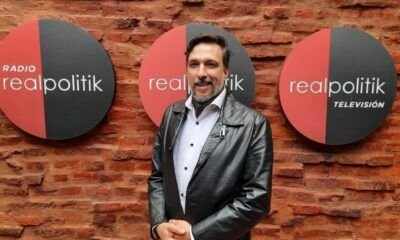INTERNACIONAL
US confirms third round of nuclear talks with Iran after ‘very good progress’

Trump threatens to abandon Russia-Ukraine peace talks
Fox News senior strategic analyst Jack Keane joins ‘America’s Newsroom’ to discuss the latest on the Trump administration’s negotiations with Iran over its nuclear program and the president’s effort to end the war in Ukraine.
The U.S. and Iran have agreed to meet for a third round of talks later this week in Muscat, Oman, after they met in Italy with Omani intermediaries to discuss Iran’s nuclear program on Saturday.
Details of the negotiations have not been released and any concrete progress in ending Iran’s nuclear program remains unclear, though a senior administration official told Fox News that «very good progress» had been made.
«Today, in Rome, over four hours in our second round of talks, we made very good progress in our direct and indirect discussions,» the official said Saturday. «We agreed to meet again next week and are grateful to our Omani partners for facilitating these talks and to our Italian partners for hosting us today.»
TRUMP SAYS IRAN MUST DITCH ‘CONCEPT OF A NUCLEAR WEAPON’ AHEAD OF MORE TALKS
An Iranian newspaper with a cover photo of Iran’s Foreign Minister Abbas Aragchi and U.S. Middle East envoy Steve Witkoff, in Tehran, April 12, 2025. (Majid Asgaripour/WANA (West Asia News Agency) via Reuters)
Reports suggested that Middle East envoy Steve Witkoff and Iranian Foreign Minister Abbas Araghchi at some point in the negotiations spoke face-to-face, the second time in as many weeks.
But the negotiations have not solely been «direct» between Washington and Tehran as President Donald Trump earlier this month insisted they would be, which Iran flatly rejected – suggesting some form of compromise was reached regarding the format of the discussions.
What Witkoff discussed directly with his Iranian counterpart remains unknown.
Araghchi also expressed some optimism in his review of the negotiations from Italy, though his perspective appeared slightly more muted.
«Relatively positive atmosphere in Rome has enabled progress on principles and objectives of a possible deal,» he wrote in a post on X. «We made clear how many in Iran believe that the [Joint Comprehensive Plan of Action] JCPOA is no longer good enough for us. To them, what is left from that deal are ‘lessons learned.’ Personally, I tend to agree.»
COL. RICHARD KEMP DOUBTS TRUMP NEGOTIATIONS WITH IRAN WILL ‘ACHIEVE WHAT NEEDS TO BE ACHIEVED’
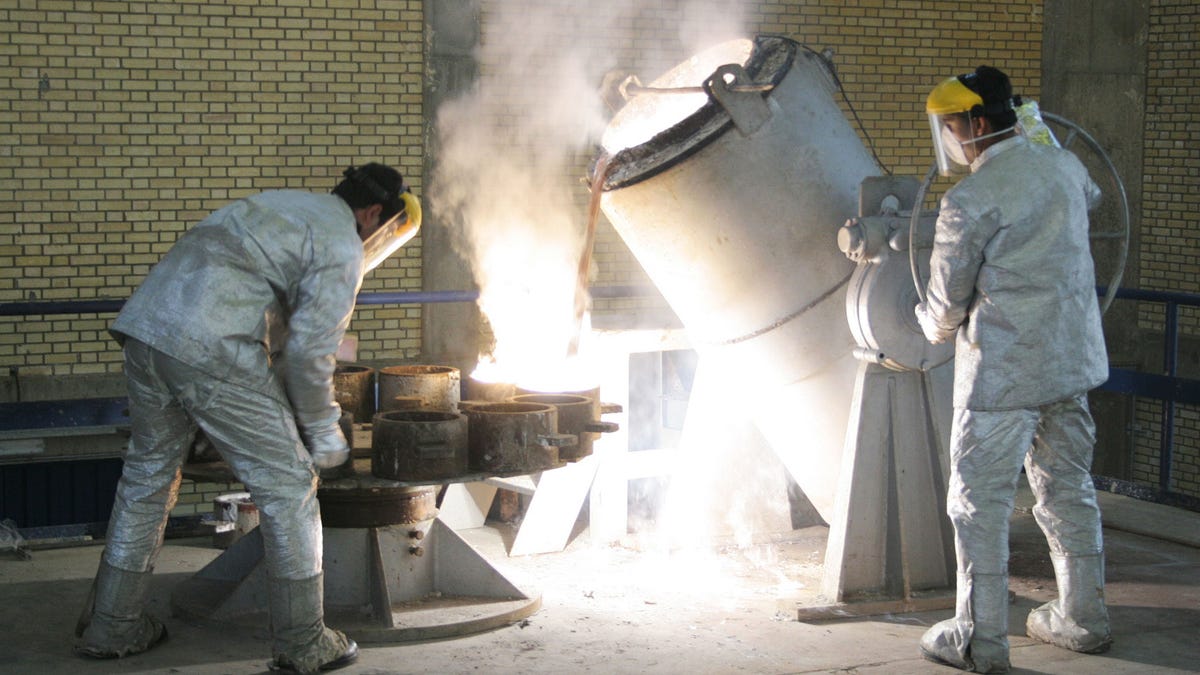
Technicians work inside a uranium conversion facility on March 30, 2005, near Isfahan, Iran. (Getty Images)
«The initiation of expert level track will begin in coming days with a view to hammer out details,» Araghchi said. «After that, we will be in a better position to judge. For now, optimism may be warranted but only with a great deal of caution.»
It remains unclear how this round of negotiations to end Iran’s nuclear program will differ from the original JPCOA, an Obama-era nuclear deal which Trump abandoned during his first term, though the president and other security experts have voiced a sense of urgency in finding a solution in the very near future.
But experts have warned these talks need to be far more encompassing than the JCPOA given the current advanced state of Iran’s nuclear program, and they need to happen very soon.
«The speed with which technical talks have been agreed to is worrying for those who hope to avoid a repeat of 2013 and 2015, as are allegations of Iran’s offer of a three-step interim or phased proposal for a deal,» Iran expert and senior fellow at the Foundation for Defense of Democracies, Behnam Ben Taleblu told Fox News Digital.
«It would be the height of strategic malpractice and a political own goal to allow the Islamic Republic to force America under the Trump administration into a deal that only slightly modified the accord that Trump rightly criticized and walked away from in 2018,» he added.
Similarly, retired Gen. Jack Keane, a Fox News senior strategic analyst, many security experts are watching these negotiation attempts with «real concern» because «Iran in 2025 is not the Iran in 2015 when that first nuclear deal was made.»
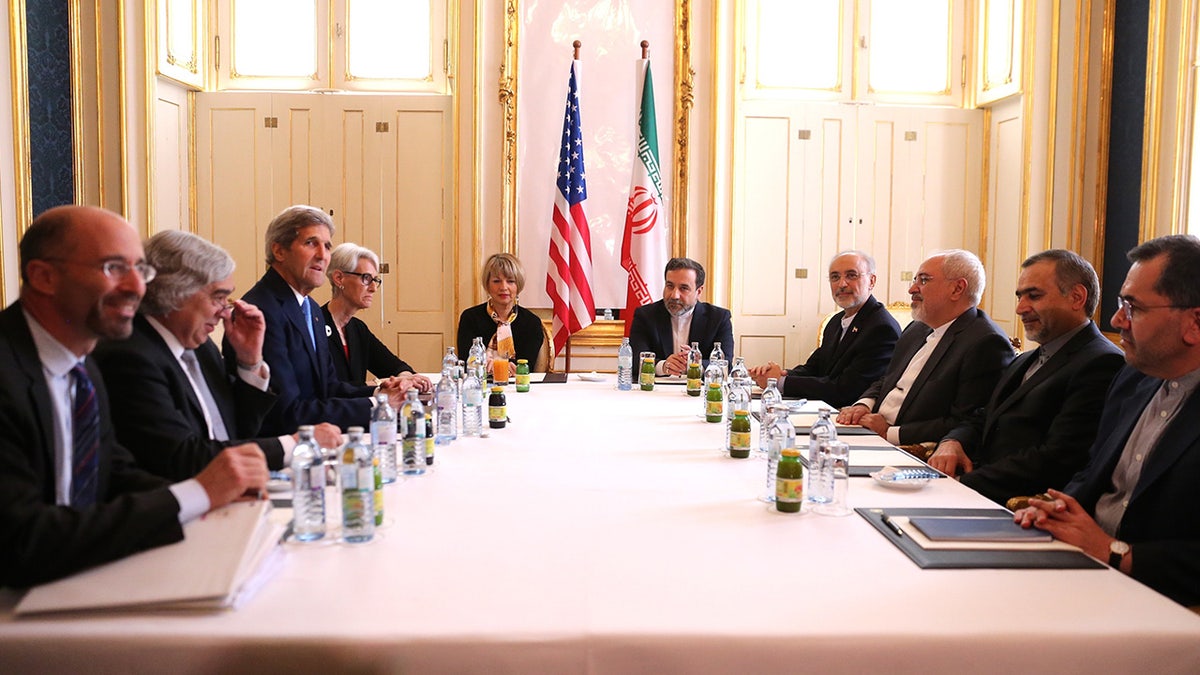
Secretary of State John Kerry, third from left, and other U.S. officials meet with EU and Iranian officials for nuclear talks in Vienna, Austria, June 30, 2015. (Pool/Siamek Ebrahimi/Anadolu Agency/Getty Images)
CLICK HERE TO GET THE FOX NEWS APP
«The difference is that Iran has the capability to manufacture advanced centrifuges which can enrich uranium from zero to weapons grade in just a matter of weeks,» Keane said.
Essentially, this means the U.S. must not only persuade Iran to get rid of its near-weapons-grade enriched uranium – enough to produce five nuclear weapons if further enriched – but also dismantle its manufacturing capabilities.
«The other thing that is different in 2025 – they have ballistic missiles that can deliver the weapon,» Keane added. «It remains to be seen what’s going to be in the deal.»
INTERNACIONAL
Pope Francis and US presidents: A look back at his legacy with the nation’s leaders
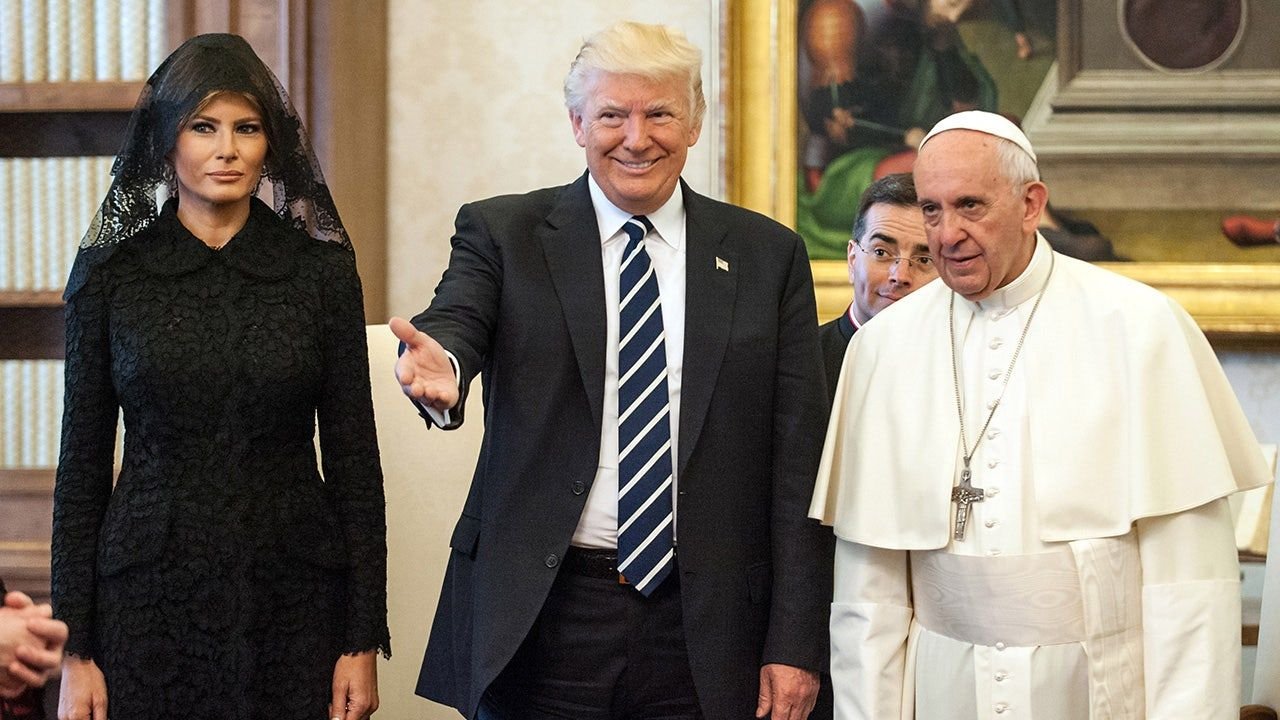
U.S. presidents mourned the death of Pope Francis, who served as the leader of the Catholic Church for 12 years, on Monday following the Vatican’s announcement of the pope’s passing.
«Rest in Peace Pope Francis!» President Donald Trump said in a post on Truth Social on Monday. «May God Bless him and all who loved him!»
The College of Cardinals elected Pope Francis, 88, to serve as the pope following Pope Benedict XVI in March 2013. His election marked the first time a non-European served as pope in more than 1,000 years. Pope Francis, born with the name Jorge Mario Bergoglio, originally hailed from Argentina.
Pope Francis, who was hospitalized in February due to complications stemming from bronchitis and pneumonia, died Monday at the Vatican’s Casa Santa Marta.
Vice President JD Vance, who converted to Catholicism in 2019, met with Pope Francis on Sunday in one of the reception rooms of the Vatican hotel just hours before the pope’s death. Vance acknowledged the visit in a post on X Monday while expressing his condolences to Christians who loved the pope, and shared a link to the transcript of one of the pope’s 2020 homilies.
POPE FRANCIS DEAD AT 88, VATICAN SAYS
Pope Francis receives U.S. Vice President JD Vance, left, before bestowing the Urbi et Orbi (Latin for to the city and to the world) blessing at the end of the Easter mass presided over by Cardinal Angelo Comastri in St. Peter’s Square at the Vatican Sunday, April 20, 2025. (Vatican Media via AP)
«My heart goes out to the millions of Christians all over the world who loved him. I was happy to see him yesterday, though he was obviously very ill,» Vance said in a post on X on Monday. «But I’ll always remember him for the below homily he gave in the very early days of COVID. It was really quite beautiful. May God rest his soul.»
Trump also signed an executive order Monday ordering all U.S. flags be flown at half-staff on all public buildings and grounds, at all military posts and naval stations, and on all naval vessels to remember Francis. The order also applies to all U.S. embassies, legations, consular offices, and other facilities abroad, including military facilities and naval vessels and stations.
Here’s a look at Pope Francis’ legacy with other U.S. leaders:
Barack Obama
Pope Francis met with former President Barack Obama at the Vatican in March 2014. The two met again in September of the following year during Pope Francis’ visit to the White House, where the pope delivered a statement urging action on climate change. Following his visit to the White House, Francis also visited New York City and Philadelphia.
Obama issued a statement Monday morning lauding the pope for his leadership.
POPE FRANCIS EXPOSES CONFIDENTIAL DETAILS ABOUT HIS ELECTION AND RELATIONSHIPS IN LENGTHY INTERVIEW
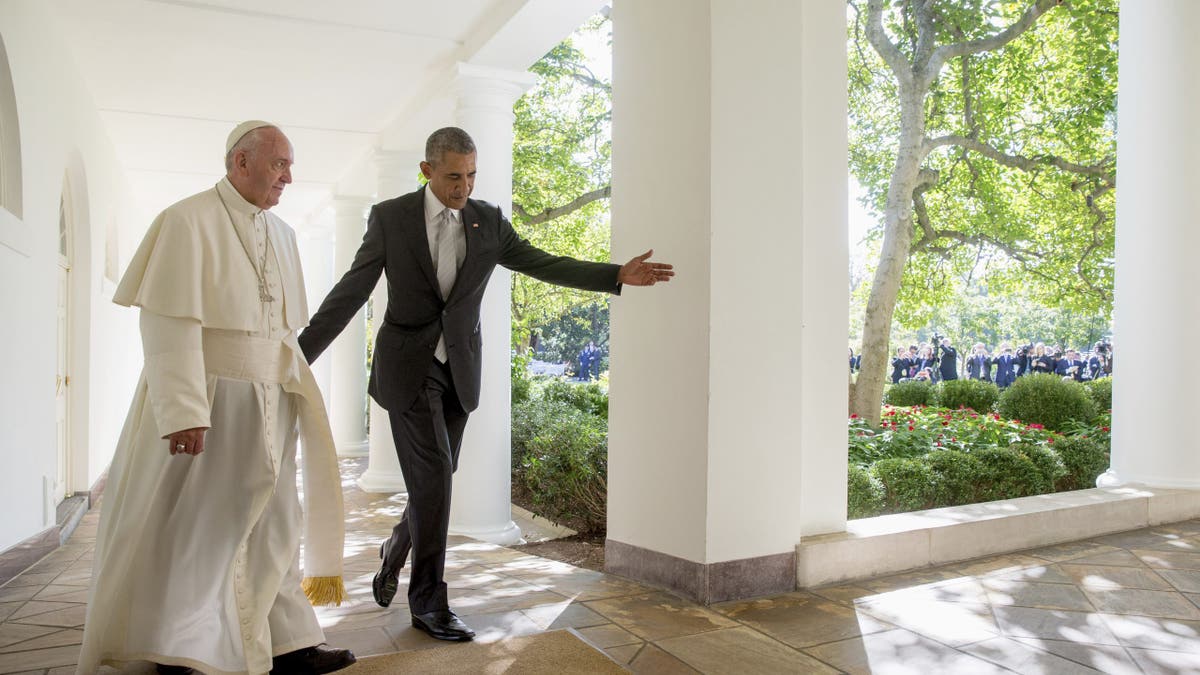
President Barack Obama and Pope Francis walk down the Colonnade before meeting in the Oval Office of the White House in Washington on Sept. 23, 2015.
«In his humility and his gestures at once simple and profound – embracing the sick, ministering to the homeless, washing the feet of young prisoners – he shook us out of our complacency and reminded us that we are all bound by moral obligations to God and one another,» Obama said in a post on X Monday morning.
«Today, Michelle and I mourn with everyone around the world – Catholic and non-Catholic alike – who drew strength and inspiration from the Pope’s example,» Obama said. «May we continue to heed his call to ‘never remain on the sidelines of this march of living hope.’»
Donald Trump
Trump met with Pope Francis in 2017 during a trip to the Vatican, and told reporters later that they had a «fantastic meeting.» However, the two remained at odds with one another over Trump’s border policies for the last decade.
«A person who thinks only about building walls, wherever they may be, and not building bridges, is not Christian,» Pope Francis said in February 2016 amid Trump’s push on the campaign trail to build a border wall and crack down on illegal immigration.

Pope Francis meets President Donald Trump in the Private Library of the Apostolic Palace in Vatican City on May 24, 2017. (Vatican/Pool/Galazka/Archivio Grzegorz Galazka/Mondadori via Getty Images)
In response, Trump said: «For a religious leader to question a person’s faith is disgraceful.»
Pope Francis routinely issued similar statements, and in February penned a letter to U.S. Catholic bishops and voiced concern about the Trump administration’s mass deportation plans.
«The act of deporting people who in many cases have left their own land for reasons of extreme poverty, insecurity, exploitation, persecution or serious deterioration of the environment, damages the dignity of many men and women, and of entire families, and places them in a state of particular vulnerability and defenselessness,» Pope Francis said in the letter.
Joe Biden
Former President Joe Biden, the second Catholic U.S. president, visited the Vatican in October 2021, where he and Pope Francis met to discuss topics including climate change and advocacy for the poor, according to a readout of the meeting.
Biden had previously met Pope Francis on several other occasions, including during the pope’s visit to the U.S. in 2015.
Biden also met with Pope Francis in June at the G7 Leaders’ Summit in Apulia, Italy, where the two discussed the ongoing Israel-Hamas war, the humanitarian crisis in Gaza, and the conflict between Ukraine and Russia, according to a readout of the meeting.
CLICK HERE TO GET THE FOX NEWS APP

Pope Francis meets President Joe Biden and First Lady Jill Biden at the Apostolic Palace on Oct. 29, 2021 in Vatican City, Vatican. (Vatican Media via Vatican Pool/Getty Images)
Biden, who awarded Pope Francis the Presidential Medal of Freedom in January, described him as a «consequential» leader on Monday who was a «Pope for everyone.»
«He was unlike any who came before him,» Biden said in a post on X Monday morning. «Pope Francis will be remembered as one of the most consequential leaders of our time and I am better for having known him. For decades, he served the most vulnerable across Argentina and his mission of serving the poor never ceased. As Pope, he was a loving pastor and challenging teacher who reached out to different faiths.»
Fox News’ Emma Colton contributed to this report.
Pope Francis,White House,Vatican News & Updates,Trump’s First 100 Days,Donald Trump
INTERNACIONAL
La portada de ‘L’Osservatore’ romano: “El Señor ha llamado consigo al Santo Padre Francisco”
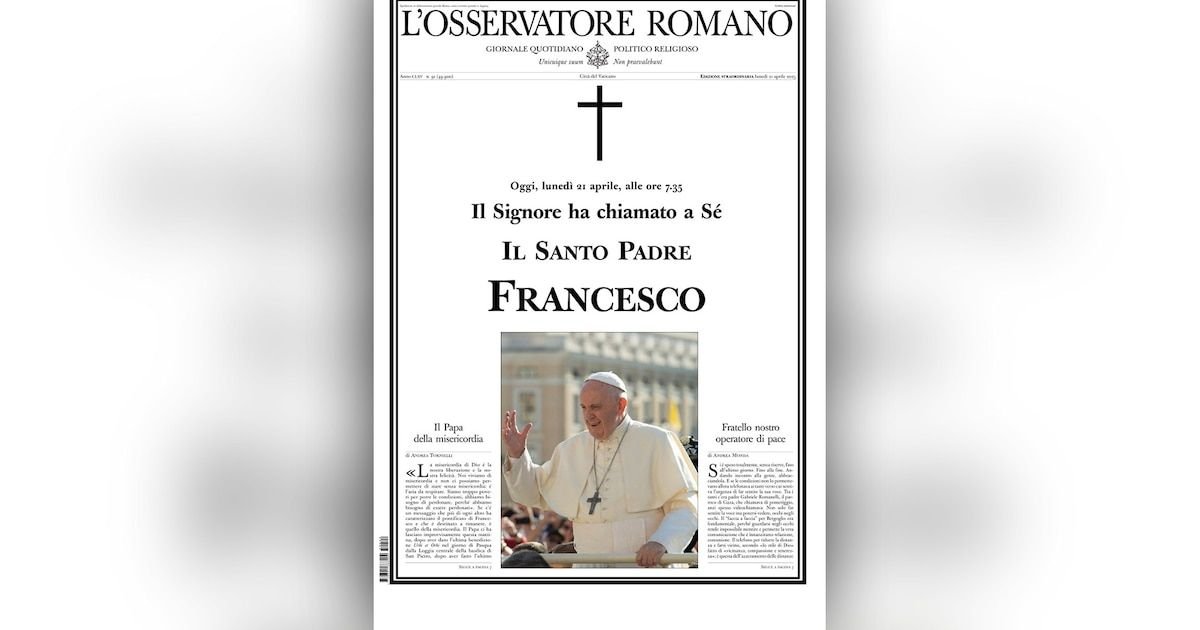
“Hoy, lunes 21 abril, a las horas 7:35, el Señor ha llamado consigo al Santo Padre Francisco”: así abre la edición del vespertino diario del Vaticano, L’Osservatore romano, anunciando la muerte con la misma fórmula que utilizó para los anteriores pontífices.
El diario, que se imprimirá en esta ocasión, ya que dejó de hacerlo hace años y solo se hace para momentos especiales, ya está preparado para ser distribuido en la plaza de San Pedro, y se convertirá en uno de los recuerdos más deseados por los fieles.
Para ello han elegido la foto de Jorge Bergoglio en los primeros años del pontificado mientras saluda a los fieles de pie en el papamóvil recorriendo la plaza de San Pedro.
En la portada figuran un artículo del director editorial de la comunicación vaticana, Andrea Tornielli, bajo el título “El papa de la Misericordia” y al lado otro del director del diario, Andrea Monda, “Hermano nuestro, trabajador de paz”.
Miles de ejemplares se distribuirán esta noche en la plaza de San Pedro con ocasión del rosario convocado para rezar por el papa Francisco, que falleció a los 88 años.

Los responsables del Dicasterio de la Comunicación del Vaticano han emitido una circular interna en la que piden a “todo el personal disponible” unirse esta tarde al plegado de las copias del periódico de la Santa Sede.

La noticia del fallecimiento del Papa repercutió en todo el mundo y los principales diarios y portales de noticias del planeta se hicieron eco rápidamente de la misma.
La prestigiosa revista TIME dio a conocer su portada, en la que se puede observar una fotografía del papa Francisco de pie con un fondo negro y cuyo texto dice: “Pope Francis. 1936-2025″.
En su obituario, titulado “El papa Francisco, el párroco del mundo que lideró en una era de crisis, muere a los 88 años”, la revista repasó la vida del pontífice argentino y los años que estuvo como líder de la Iglesia Católica.
El medio resaltó que, durante su papado, Francisco fue una figura de cambio y de apertura, que intentó acercar la institución a una feligresía fragmentada por décadas de escándalos y por profundas tensiones doctrinales. Fue también el primer papa del hemisferio sur, el primero del mundo en desarrollo, y el primero en adoptar el nombre de Francisco en honor a San Francisco de Asís, símbolo de pobreza y humildad.
Su elección, el 13 de marzo de 2013, fue leída como una señal de que los cardenales buscaban un cambio de rumbo. “Parecía que los cardenales tuvieron que ir hasta el fin del mundo para encontrar un Papa”, dijo desde el balcón de la Basílica de San Pedro en sus primeras palabras al mundo, aludiendo a sus raíces argentinas.

Jorge Mario Bergoglio nació el 17 de diciembre de 1936 en Buenos Aires, hijo de inmigrantes italianos que huyeron del fascismo. Creció en una familia modesta de clase media baja, profundamente influenciada por su abuela Rosa, quien lo introdujo en la fe católica. Su vocación sacerdotal surgió a los 16 años, tras una experiencia mística en la iglesia de San José de Flores. “Sentí como si alguien me agarrara por dentro y me llevara al confesionario”, contó en una entrevista radial.
Fue ordenado sacerdote jesuita en 1969, y en 1973, con apenas 36 años, fue nombrado provincial de los jesuitas en Argentina.
Durante los años 90, vivió en una residencia jesuita en Córdoba, un período que describió como “una época de gran crisis interior”. Regresó a Buenos Aires como obispo auxiliar en 1992, y en 1998 fue designado arzobispo de la ciudad. En 2001 fue creado cardenal y en 2005 asumió la presidencia de la Conferencia Episcopal Argentina.
Al llegar al papado tras la histórica renuncia de Benedicto XVI, Francisco imprimió un nuevo tono: vivió en una residencia modesta en lugar del Palacio Apostólico y reformó las finanzas vaticanas al ordenar una auditoría del Banco Vaticano, que resultó en el primer informe financiero en más de un siglo. Fue también el primer papa en asistir a una cumbre del G7 y en visitar Irak, además de adoptar un enfoque más compasivo hacia los desafíos contemporáneos.
“Si alguien es gay y busca al Señor y tiene buena voluntad, ¿quién soy yo para juzgar?”, dijo en 2013. Diez años más tarde, aprobó una norma que permite bendecir a parejas del mismo sexo, aunque reiteró que el matrimonio entre personas del mismo sexo “no es matrimonio”.
También impulsó reformas en el tratamiento pastoral de personas divorciadas y en el acceso a las anulaciones. “La Eucaristía no es un premio para los perfectos, sino una poderosa medicina y alimento para los débiles”, escribió en Amoris Laetitia. Aunque mantuvo la posición tradicional sobre el sacerdocio reservado a los hombres, creó comisiones para estudiar la posibilidad de ordenar diaconisas y se mostró receptivo a permitir sacerdotes casados en regiones con escasez clerical, aunque no llevó adelante esa reforma.

Francisco fue una figura central en momentos de crisis internacionales. En 2022, tras la invasión rusa de Ucrania, exhortó a Vladimir Putin a “detener esta espiral de violencia y muerte”. También condenó los ataques en Gaza durante la guerra entre Israel y Hamas, y mantuvo comunicación con comunidades afectadas, incluso mientras estaba hospitalizado.
Durante la pandemia de COVID-19, impartió una bendición solemne desde una Plaza de San Pedro vacía, instando a los fieles a mantener la fe: “Nos encontramos asustados y perdidos”, reconoció.
En materia ambiental, su encíclica Laudato Si fue un llamado urgente a combatir el cambio climático. “El clima es un bien común, de todos y para todos”, escribió. Su intervención fue considerada clave para movilizar el apoyo de países de mayoría católica al Acuerdo de París.
Francisco también tuvo que enfrentar el legado del abuso sexual dentro de la Iglesia. En 2018 fue duramente criticado por defender al obispo chileno Juan Barros, acusado de encubrir abusos cometidos por su mentor. Tras una investigación, pidió disculpas a las víctimas y admitió: “Fui parte del problema”.
En 2019 expulsó del sacerdocio al ex cardenal Theodore McCarrick, acusado de abusos, en una decisión sin precedentes.
También levantó el secreto pontificio sobre los casos de abuso, facilitando su denuncia ante autoridades civiles.

Su estilo sencillo y accesible le valió apodos como “el párroco del mundo”. Lavó los pies de reclusos, se negó a usar vehículos lujosos y prefirió siempre un lenguaje directo. En 2016 canonizó a la Madre Teresa y promovió el diálogo interreligioso: viajó a Emiratos Árabes Unidos, donde firmó un documento por la paz con el Gran Imán de al-Azhar. “El Documento sobre la Fraternidad Humana” se convirtió en una de las declaraciones más relevantes del pontificado en materia de convivencia religiosa.
También procuró acercarse a los pueblos indígenas. En 2022, viajó a Canadá para pedir perdón por el rol de la Iglesia en los abusos en internados religiosos. “Estoy aquí para recordar el pasado y llorar con ustedes”, dijo a las comunidades originarias.
TIME destaca que el papa Francisco supo utilizar las redes sociales como herramienta pastoral. Fue el primer papa en participar de un Hangout de Google y en batir récords en Instagram. En palabras del cardenal Timothy Dolan, “la gente dice: ’He estado alejado de la Iglesia durante un año, pero el papa Francisco me está atrayendo de vuelta’”.
En una entrevista de 2014, habló con naturalidad de su propia muerte. “Sé que durará poco tiempo. Dos o tres años y luego me iré a la casa del Padre”. Ese momento llegó hoy, más de una década después de haber sido elegido sucesor de Pedro, enfatizó la revista.
“Nos enseñó a vivir los valores del Evangelio con fidelidad, valentía y amor universal”, recordó el cardenal Farrell. “Con inmensa gratitud por su ejemplo como verdadero discípulo del Señor Jesús, encomendamos el alma del papa Francisco al infinito amor misericordioso del Dios Uno y Trino”.
Europe,Religion / Belief,THE VATICAN
INTERNACIONAL
Pope Francis revealed burial wishes just days after becoming pope in 2013

Just a few days after becoming pope, Pope Francis revealed his burial wishes upon his death.
In March 2013, Pope Francis was elected during a conclave by the Cardinals of the Catholic Church following Pope Benedict XVI’s decision to step down amid health concerns.
«It was his belief that he may not live very long,» Neomi DeAnda, a trained constructive theologian, told Fox News Digital. «He was already in his 70s when he was elected pope, and he wanted to be prepared when God called him home.»
THEOLOGIAN ON ‘CONCLAVE’ ACCURACY, EXPECTATIONS FOR NEXT SECRETIVE EVENT AFTER POPE FRANCIS’ DEATH
Pope Francis selected the Basilica of Santa Maria Maggiore as his final resting place just days after being elected pope in 2013. (Yara Nardi/Reuters)
DeAnda holds a Ph.D. in theology from Loyola University in Chicago, a master’s in theology from the Oblate School of Theology and a master’s in theology from St. Mary’s University in Texas. She is an expert in Latin American studies and on Mary in Latin America.
«He did not know how much longer he would live, and since he was chosen pope at an older age, he definitely did not expect to have such a long papacy,» DeAnda said. «He wanted to have his wishes available in case God called him home.»
Pope Francis selected the Basilica of Santa Maria Maggiore as his final resting place.
«It has some significance for his grandparents,» DeAnda told Fox News Digital. «His grandparents were the ones who immigrated to Argentina with his dad and, I believe that they lived close to and visited that Basilica.»
WHAT IS THE PAPAL CONCLAVE: INSIDE THE ANCIENT PROCESS OF CHOOSING THE NEXT POPE

Pope Francis met with Vice President JD Vance on Easter Sunday, just hours before he passed away. (Vatican Media via AP)
On March 13, 2013, Pope Francis appeared for the first time in public as pope at the Basilica.
«That has been his favorite place to visit,» DeAnda said. «It’s a place that he goes to every time that he is going on a trip. He goes there to pray before he goes on a trip.»
Pope Francis, born Jorge Mario Bergoglio in Argentina, was the first pope from the American continents.
His family escaped facism in Italy and fled to Argentina, according to his autobiography.
«There is a great story about how they were trying to board a certain boat, a certain ship for their immigrant travels, and they did not make that ship because they were not able to sell all their goods,» DeAnda said of Pope Francis’ dad and grandparents. «That ship is called the SS Principessa Mafalda.»
CLICK HERE TO GET TO THE FOX NEWS APP
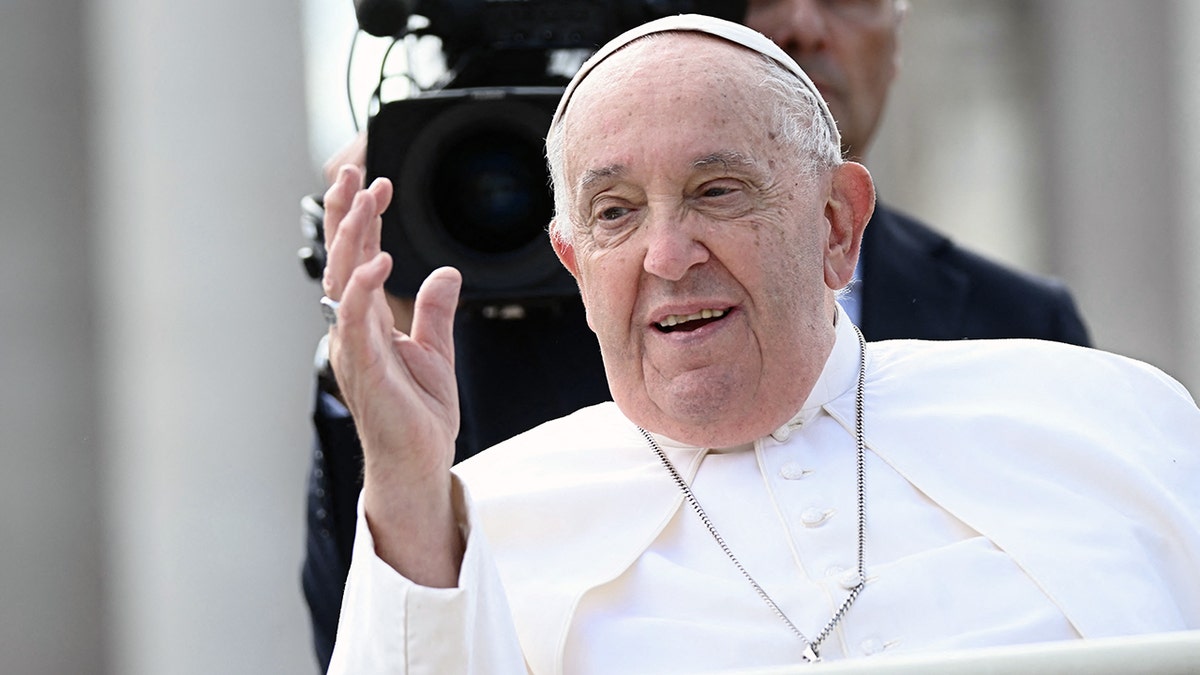
Pope Francis often visited the Basilica of Santa Maria Maggiore, a place that reminded him of his family. (Filippo Monteforte/AFP/Getty)
DeAnda added that the ship meant to carry Pope Francis’ family capsized.
«It’s possible that his grandparents would have died on that ship,» DeAnda said. «They made it on that ship, and then we get Francis and his 10 siblings because of that.»
The Vatican revealed that Pope Francis passed away on April 21, 2025, the day after Easter Sunday.
-
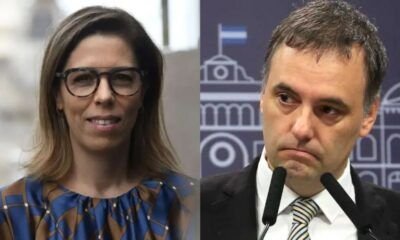
 POLITICA1 día ago
POLITICA1 día agoEl PRO criticó a Manuel Adorni: “Prefieren perder por un punto contra Leandro Santoro a que le ganemos al kirchnerismo”
-

 POLITICA3 días ago
POLITICA3 días agoAuditoría sobre discapacidad: una mujer se disfrazó para poder cobrar la pensión de su marido fallecido; también recibían el subsidio prófugos y falsos amputados
-

 POLITICA2 días ago
POLITICA2 días agoDenuncian a un juez por frenar una causa contra Cristina que permitiría recuperar US$1125 millones de la corrupción















